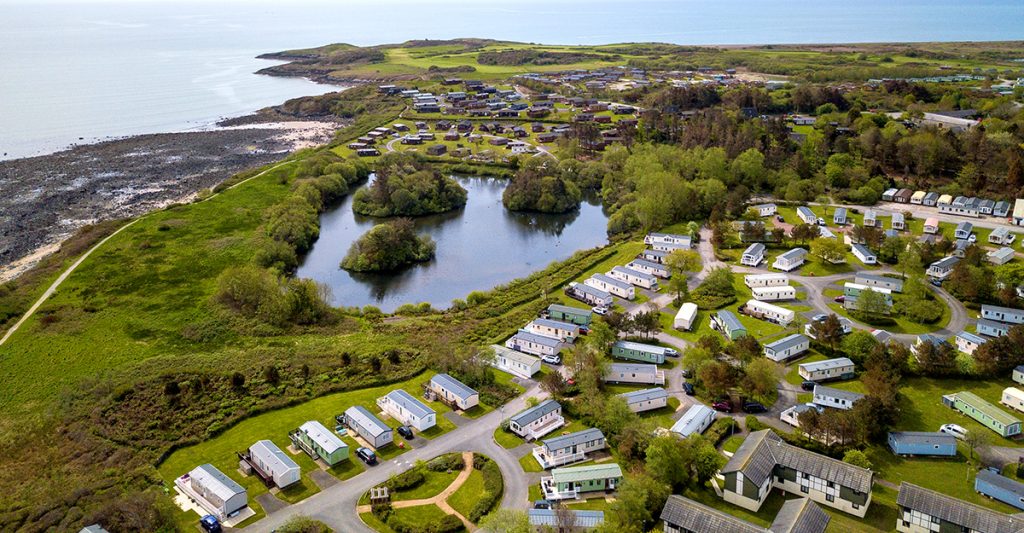How to Maximise Your Income: Revenue Management for Holiday Parks
If we told you there is a way to predict demand, always secure the greatest possible number of bookings and maximise your profits, would you believe us? We are not talking about tea leaves, crystal balls or the alignment of the cosmos. This is a science. It is called revenue management. In the context of revenue management for holiday parks, the practice can be defined as:
Selling the right accommodation, over the right dates, to the right guest, at the right time, for the right price, through the best channel, at the lowest cost.
The key to achieving this mission statement is to set your pricing at optimum rates then review and amend them regularly. Data and analytics are what will guide you to your optimum rates. Simply put, revenue management is about getting the greatest possible value from your holiday lettings.
Here is how it is done.

Glimpse the future
To predict the future, study the past and the present. In the terminology of revenue management, this is called forecasting. It involves looking at your past data, your present data, and analysing industry trends. When you do this, and you will begin to spot patterns in the behaviour of your bookers and guests. And as we know, patterns have a habit of repeating themselves.
Past data
The place to find patterns in the behaviour of your bookers is the past data stored in your historical records. Look for patterns such as regularity in the dates and times of year when your guests make most of their bookings and the weeks and months in which your park is busiest with holidaymakers. You can use these insights to predict, plan and adjust for future ebbs and flows in demand.
These are good places to start but are not the only patterns worth looking for. Any and every pattern you identify will reveal new insight into the ways that your guests behave. The better you understand how your guests think and act, the better you can sell to them. It is a good idea to decide what aspects of your guest’s behaviour would be useful for you to know. Once you have, you can delve into your data and look for relevant patterns.
Present data
If you keep a keen eye on what your guests and bookers are doing in the present you can catch new patterns as they emerge. Are you experiencing a spike in bookings for particular dates? Are bookers suddenly rushing to book up one type of accommodation you offer? Some new patterns will become entrenched; others will shoot up like rockets, burst into a brilliant shower of sparks, then fade into the air never to be seen again. But no matter. Catch any trend, whether long term or short, adjust for it accordingly, and you can make money from it.

Annual events
The warmer months, school holidays and annual celebrations such as Christmas and Easter will always influence demand across the holiday sector. This knowledge becomes especially useful to you if you compare how much demand varies for you during these times of year to others.
Industry trends
Trends come and go in the holiday sector just as colours, fits and fabrics go in and out of fashion. These trends are often driven by wider trends in society. The growth in awareness of global warming, for instance, has meant that more and more of us are taking interest in eco-friendly holiday experiences and accommodation.
Other trends are more general. Certain areas enjoy phases of increased popularity. Widely viewed television series filmed in enticing real-world locations are one example of potential holiday trend influencers. It is probably safe to assume that lots of people have seen the golden beaches and green meadows of Cornwall in Poldark and thought “it looks nice there, doesn’t it?”. Holiday sector trends may affect demand for bookings on your park, so it is worth keeping up to date with them.
Disrupters
Patterns get disrupted from time to time. Disruptions can be big or small. Some will appear out of nowhere like freak spring hailstorms, but others can be foreseen and prepared for. Few, if anyone, could have predicted the Covid-19 pandemic and how disruptive it would be. Other disruptors, however, are easier to identify as and before they emerge.
Has a big new attraction opened near your park? Is a one-off regional event taking place close by this year? Are extensive long-term roadworks planned on a vital road that connects your park to major national travel networks? All such events would likely affect your bookers’ long or short-term behavioural patterns. But remember, you can often put necessary adjustments in place before disruption hits by identifying when it is likely to happen.
It is a good idea to pay attention to changing habits, too. Customers are quick to drop, change, and pick up new habits. Changes in customer habits can be abrupt or gradual. The important thing is to pick up on them then work out how they might impact your business, then how you might capitalise on them or guard against them.
Revenue management for holiday parks strategies
There are many revenue management strategies that can help you make more money. The ones listed below are those that are most relevant to revenue management for holiday parks.

Get to know your market
If you want to learn how to get the maximum possible value from your guests, you will need a sound knowledge of the market in which your park operates. Start with your guests. What are they like? Where do they live? And perhaps most importantly, what do they want from a holiday experience? The trick is to gather and keep as much data about your guests as possible.
It is strongly advisable to invent profiles of your typical guests – ‘buyer personas’ as they are known in marketing terms – if you have not already. You can use these profiles to store and quickly look up the information you have found about your different types of typical guest. Other information that is good to note on these profiles includes the times of year your typical guests like to holiday, when they like to book, what accommodation they prefer, how long they typically stay, and how they like to make their booking.
It is also worth thinking about other holiday parks in your area. What are their main selling points? Do similar guests holiday there, or do they attract different crowds? Consider demand too. By how much does it change during the year? How is it affected by the seasons?
The better you know your market, the greater your ability will be to find and exploit the gaps within it.

Segmentation and Price Optimisation
Discount pricing
Thanks to your forecasting, you know when your slow periods will be. Lowering prices will help to keep guests flowing through your gates during these times. With more guests onsite, you can recoup revenue from your additional services.
Increased pricing
On the other hand, the times when your park is busiest are those when you might want to up your prices. When demand is high and availability is low, people are more inclined to splash extra cash to secure what they want. Make the most of this.
Value-added pricing
Illusions of luxury can be lucrative. To conjure one, look at the prices other holiday parks in your area charge then set yours higher. Offset the extra expense to your guests by offering more included extras than other local parks do. This will help make people think that you and your park are the providers of the premium holiday experience in your local area.
Pricing by segment
Often, different prices work better for different ‘types’ of guest. Thanks to your well-gathered, stored and managed data, you know the broad category ‘types’ your guests fall into. Examples likely include families and older couples. Again thanks to your data, you have an idea of how much these types of guest spend onsite. Lower prices might be more appropriate for guest types who spend more onsite because they are of greater overall value.
Length of stay
Occupied rooms make money, vacant ones lose it. To encourage guests to book longer stays, you could discount bookings of, say, 10 or more days. You could also introduce a minimum stay rule obliging guests to book a certain number of nights or more.

Improve and expand your revenue stream
Simple, old-fashioned, time-tested money making methods are often just as important as clever revenue management strategies. Here are two that are always worth remembering.
Establish and uphold your reputation
If your park has a reputation as a good place to holiday, more people will want to book a stay there. It is that simple. An easy way to score a big reputational win is to focus on the quality of your customer service. According to a study by the American software company Salesforce, 62% of customers say they share their best experiences with others. Continuously build on your reputation for offering great holiday experiences and demand from potential guests will keep rising.
Sell a variety of products
Bars and restaurants are obvious examples. Both can be big cash earners. But there are other things you can sell besides food and drink. Think about what people might want or need in order to enjoy what your local area has to offer. Bike rental and sales of puncture repair kits could be nice side-earners if your park is in an area with lots of cycling trails. Are there any big attractions nearby that most of your guests will want to visit during their stay? If so, have you considered striking a deal with the attraction’s owners to sell tickets to your guests?
Revenue management for holiday parks KPIs
Below are the metrics you can use to measure the success of your revenue management policies. The technical term for these metrics and others used to measure the performance of an organisation or its activities is ‘key performance indicators’, which is often abbreviated to ‘KPIs’.
Revenue per accommodation unit
You can use this metric to determine how much money your accommodation is bringing in. It considers your total number of holiday accommodation units and is not concerned with whether they are occupied. To calculate the number, divide your total revenue by the number of accommodation units on your park.
Profit per accommodation unit
This measure reveals the average price that each of your accommodation units is earning for you. It is similar to revenue per accommodation unit but is used to calculate how much your accommodation is making for you rather than simply bringing in. To calculate your profit per available accommodation, divide the gross profit your accommodation creates by the number of accommodation units on your park.
If you want, you can apply the two above measures to reveal how much money the different types of accommodation on your park are bringing in and how much profit they are generating. To do this, simply swap the total numbers for the specific number of units of the accommodation type you want to measure and the revenue or profit generated by that accommodation type, then use the same formula to make your calculation.

Average revenue per account
Use this metric to see how valuable your guests are to you. This measure reveals the average revenue that each of your guests has generated for you over a set period. To get the number, divide your total recurring revenue (usually monthly or yearly) by your total number of guest accounts. If you have segmented your guest accounts into different types of guest, you can also use this KPI to calculate and compare the values of your various guest ‘types’.
Occupancy rate
Your occupancy rate is the percentage of your accommodation units that are occupied at a given time. This is one of the best measures you can use to judge the efficiency of your business. High occupancy rates are solid indicators that you are doing a good job of attracting guests.
To calculate your occupancy rate, divide your total number of occupied rooms by your total number of rooms available. For example, if your park has 100 accommodation units and 80 of those units are occupied, divide 80 by 100. The 0.8 that will appear on your calculator indicates an occupancy rate of 80%. Finding your accommodation pricing sweet spots will help you strike the golden balance between strong revenue and high occupancy rates.
Customer lifetime value
In the context of a holiday park business, customer lifetime value (CLV) is an estimation of the total revenue that a guest is likely to generate for a park during that guest’s lifetime.
Before you can calculate CLV, you must first make some prior calculations.
1. Average purchase value
To calculate your average purchase value (APV), divide the total revenue that your park generated within a period (usually one year) by the number of purchases made within that period.
2. Average purchase frequency rate
To calculate your average purchase frequency rate (APFR), divide the total number of purchases made by the number of unique customers within a period (again, usually a year).
When calculating APV and APFR for the purpose of calculating CLV, use the same period to calculate both numbers. Once you have your APV and APFR, use these numbers to calculate your customer value.
3. Customer value
To calculate your customer value (CV), multiply your APV by your APFR.
4. Average customer lifespan
Next, you will need your average customer lifespan (ACL). To calculate this number, average the number of days between the date of the first and last orders made by every one of your previous guests. This calculation will produce your ALC in days. To convert the number into years, divide it by 365.
Now that you have your CV and ACL, you can calculate your customer lifetime value using this formula:
Customer value x average customer lifespan = customer lifetime value
CLV is most useful when used to calculate the value of your main types of guest. You can do this by calculating the CLV for several guests who closely match the profile of one of your typical types of guest (buyer personas) then take an average. By doing this, you can identify roughly how much revenue each of your typical guest types makes for your business. You can then ensure that the wants and needs of your most profitable guest types are prioritised. This will encourage more of these guests to holiday at your park and help secure the loyalty of the ones who already do.
Net asset value
Net asset value (NAV) is the value of a business or an entity’s assets minus its liabilities. To calculate NAV, simply add up the total value of your park’s assets then subtract the total value of its liabilities. This metric can provide you with a valuation of your park in terms of its physical assets. One important asset it does not account for, however, is your park’s brand.
Brand value
Your brand is the icing, the jam, and the sweet ornamentation that garnish the cake of your business (its physical assets). It is your business’s flavour and look: the little details and characteristics that distinguish it, make it memorable and signal its unique appeal. Logos, design preferences, etc… These are all part of a brand and a brand identity, but the essence of your brand and its value is what these things are designed to influence – that is, the way your business is perceived by the public.
Public perception is non-physical. As such, brand value refers to your business’s non-physical value. This can be a little difficult to understand, so here is a good way to think of it: a brand’s value is indicated by the frequency that people are willing to choose and the extra they are willing to pay for the products or services of that brand over those of its competitors.

Because the essence of a brand is non-physical, brands cannot be precisely measured. This makes their value difficult to determine. There are, however, a few methods available to help you put an approximate price tag on your park’s brand.
Cost-based brand valuation
This metric assumes that the financial value of a brand is equal to the cost that has gone into creating that brand. How much have you spent creating and promoting your brand? Add up all your historical marketing, advertising, and brand design costs and you will have your cost-based brand valuation. But be wary of this metric. It is useful for estimating cost if you are considering a rebrand but does not account for industry changes, media attention, and other contextual variables that can have a powerful influence on the way people see and think about your business.
Market-based brand valuation
Judge the value of your brand by comparing the values of brands belonging to similar parks. That might include similar sized parks, parks that offer a similar range of accommodation, other parks in your local area, and so on. The more brand values you can compare, the better, as this will give you a more precise yardstick against which you can estimate the value of your brand. Values for comparison can be sale prices or stock market quotations.
Income-based brand valuation
Also commonly referred to as the ‘in use’ approach. This means of brand valuation is based on your brand’s power to generate income. That income can be actual, potential, or predicted. If you were to hire out your brand, how much could you charge for it? That price is your income-based brand valuation.
As with revenue management strategies for holiday parks, these revenue management KPIs are only a few of many you could use to measure the financial performance of your business. But generally speaking, these are the most relevant to revenue management for holiday parks.
Data management for holiday parks
As you have probably guessed, when it comes to revenue management for holiday parks, data is all-important. If you want to use data effectively, you will first need to put in place reliable systems to gather, store, and manage it.
A good place to begin is to consider encouraging a company-wide ‘revenue culture’. One way to achieve this is to explain the importance of data gathering to all your staff members and ask them to help with the task in whatever ways they can. Do certain types of guests, for example retired couples, prefer certain meals and to eat at certain times? Your restaurant staff will be able to find out and tell you.
Anything and everything you can find out about the behaviour and preferences of your guests is potentially useful from a revenue management perspective. A high company-wide standard of customer service is essential for a healthy revenue culture.

Final advice
A well-calculated price is the tip of an unseen iceberg of research, forecasting and strategy. There is a lot to consider. But do your revenue management well, and if your onsite services and digital and traditional marketing efforts are up to scratch, and your park’s profits will boom.
Nonetheless, revenue management is complicated. You can save time and generate greater revenues by getting professionals to do the job for you.
The Gold Standard Service
Michael Paul’s Gold Standard service is ready and waiting to provide you with a virtual back office staffed by a 17-strong team of UK holiday lettings experts including experienced revenue managers. The team is poised to optimise all areas of your park’s revenue management.
If you wish, the service can also handle your digital marketing, traditional marketing, bookings process and customer services.
All work produced by your virtual back office will be done in your name, under your brand. Best of all, the costs are guaranteed to be outweighed by what is likely to be £1000s of extra income that the service will earn for you.
To discuss how the Gold Standard service will benefit your business,
call Michael Paul on:
01275 371133
or email him at:
michael@michaelpaulholidays.co.uk

One reply on “How to Maximise Your Income: Revenue Management for Holiday Parks”
1daughter-in-law